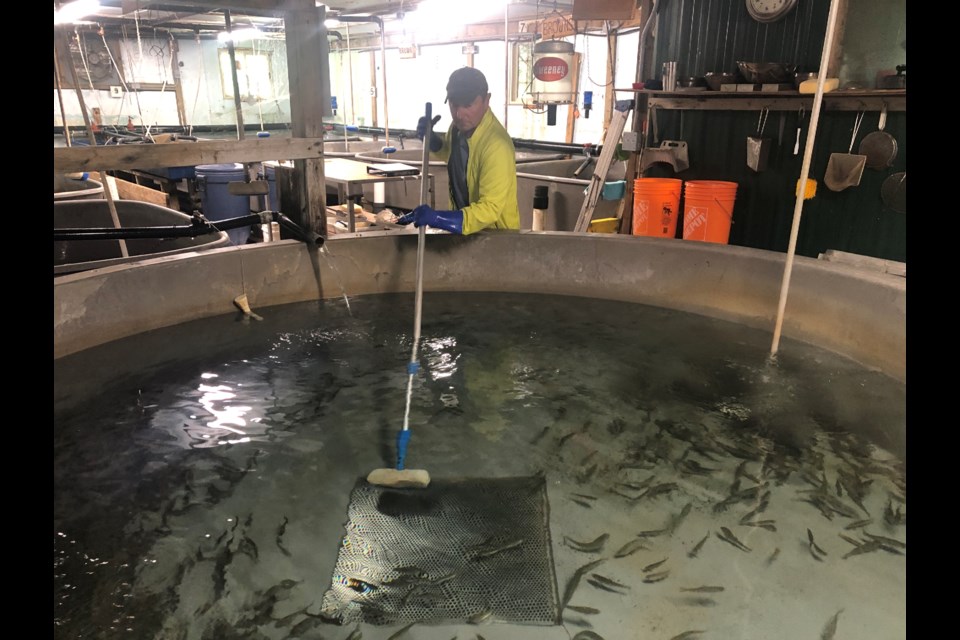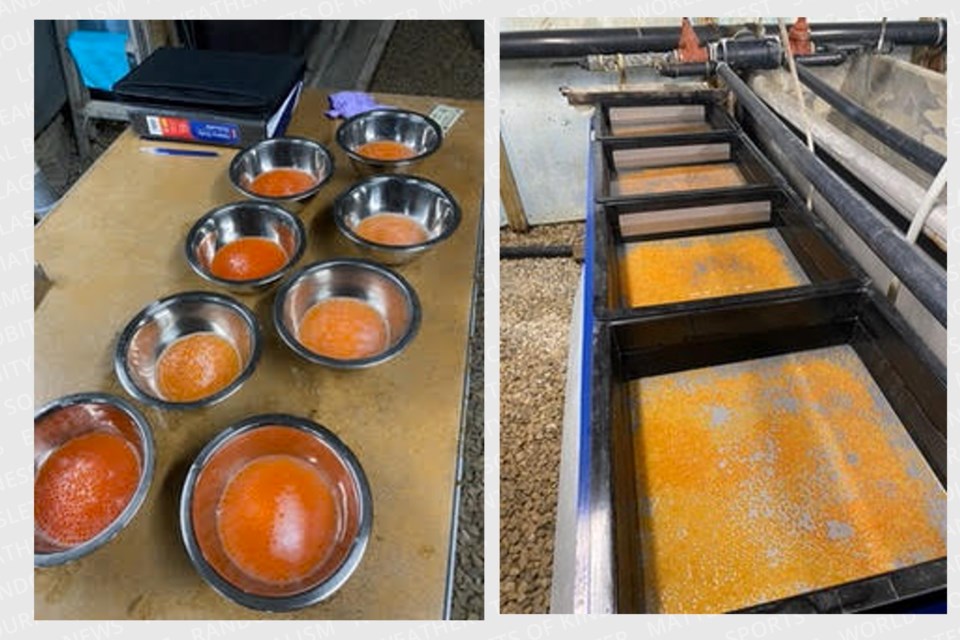Local anglers keep fish hatchery running for 3 decades
Local anglers have been doing a lot more than catching and releasing fish in Collingwood waterways, they’ve also been hatching, feeding, rearing and releasing them.
Since 1985 the members of the Georgian Triangle Anglers’ Association have been running a fish hatchery out of an indistinct and low-roofed building perched on the riverbank of Black Ash Creek high up Blue Mountain.
With some food money and eggs from the Ministry of Natural Resources and Forestry, and a lease for a spot on the Nottawasaga Valley Conservation Authority’s Petun Conservation Area, the local anglers have volunteered time and money to make sure the local fish population has a good chance to thrive.
Rick Baldry, owner of Rick’s Happi Hooka tackle shop in Collingwood, president of the local anglers’ association and a life-long fisher in local creeks, rivers and the bay, has been involved in the hatchery work since its early days.
He joined a group of other tradesmen in building and maintaining the hatchery system and tanks, using funds collected through the annual spring trout derby and other Georgian Triangle Anglers’ Association events.
“The first hatchery was in a tent,” said Baldry.
Later two other buildings were constructed and rearing tanks added. A hand-built system inside the hut brings in fresh water from Black Ash Creek and returns it as outflow.
“It was all volunteer-built,” said Baldry. “Goodyear would give us their ‘seconds,’ and others would give us used parts. And there were a lot of skilled tradespeople volunteers.”
The Georgian Triangle Anglers’ Association Hatchery is part of the Ontario Federation of Anglers and Hunters Community Hatchery Program and it operates 365 days a year.
The hatchery typically houses between 90,000 and 100,000 fish in various growth stages.
About 70 per cent of the fish hatched in the facility will survive and be released into local waterways.
There are three types of fish grown at the hatchery: rainbow trout, brook trout and brown trout.
For the rainbow trout, volunteers with the Georgian Triangle Anglers’ Association have permission to harvest eggs and milk from trout at the Thornbury fish ladder once a year. Once the necessary materials are harvested, the volunteers mix the eggs and milk in a bowl and put it into egg trays at the hatchery. A rainbow trout will stay at the hatchery for about a year and grow to about two inches long before it is released in Mill Creek. They imprint there and that helps them return to the creek during spawning season.
Fertilized brown trout and brook trout eggs arrive to the hatchery from the Ministry of Natural Resources and Forestry.
Brown trout stay the longest (about two years) and grow the largest (six to eight inches) because they get released into Georgian Bay.
“They have to go in bigger, big enough to survive predators,” said Alfano.
The hatchery received 30,000 brown trout eggs on Dec. 20, and those produced 28,000 “baby browns.”
Brook trout grow for about 16 months at the hatchery to between four and six inches before they are released into waterways like Pretty River or Pine River.
“Brook trout get released just for the kids to catch,” said Alfano. “Rainbow and Brown trout are released with the hope of increasing the natural population.”
The water in the hatchery is monitored for temperature and quality, and the outflow from the hatchery is also monitored for quality.
It was Baldry who recruited Alfano while the latter was at Rick’s Happi Hooka buying tackle.
Alfano’s interest in fishing prompted him to volunteer at the hatchery, where he’s now the chairperson who coordinates the other volunteers.
“It’s not a lot of my time, and it’s giving back to the community. And volunteer work makes you feel good,” said Alfano, who noted the rewarding nature of feeding and caring for the hatchlings. “To take those bags of eggs and to get to this stage where they’re going out into the bay is fantastic.”
Baldry is also a lifelong fisherman, and that’s kept him involved in the hatchery operations.
“I used to fish 100 to 150 days a year, and I’ve been fishing since I was three years old,” he said.
He recalled the days in his childhood when he would buy two hooks at the hardware store for a penny and tie them to butchers twine. He’d use pieces of bread as bait to catch minnows and use those to catch larger fish.
His vision for the hatchery is not only to help grow the local fish population, but also to help inspire children and youth toward conservation.
“For kids to see this, can you imagine the value?” he said. “You can’t teach a lot of this stuff, but you can show it … conservation is our only means of securing the future.”
He said he’s seen the efforts of the Georgian Triangle Anglers’ Association hatchery and supplementary re-stocking pay off with an increase in rainbow trout in the areas of Meaford, Thornbury, and Collingwood.
But the work must continue, and that means finding more volunteers to keep the hatchery going and the fish fed.
“Our volunteers put in over 1,000 hours per year,” said Baldry. “But our club members are getting older.”
The local anglers’ association is looking for volunteers willing to help out at the hatchery.
A volunteer shift at the hatchery is between one and two hours and typically involves feeding the fish and recording temperatures. Alfano said he will work with volunteer’s schedules and commitment levels.
The hatchery needs many volunteers at the moment, and no relevant experience is necessary as the current volunteers will train new ones.
Students are welcome, and Alfano said it’s a good experience for students who might be interested in a career in the environmental sciences.
If you’d like to volunteer to help feed the fish and clean the tanks, email Nick Alfano at nick.alfano@rogers.com.

.jpg;w=960;h=640;bgcolor=000000)


























